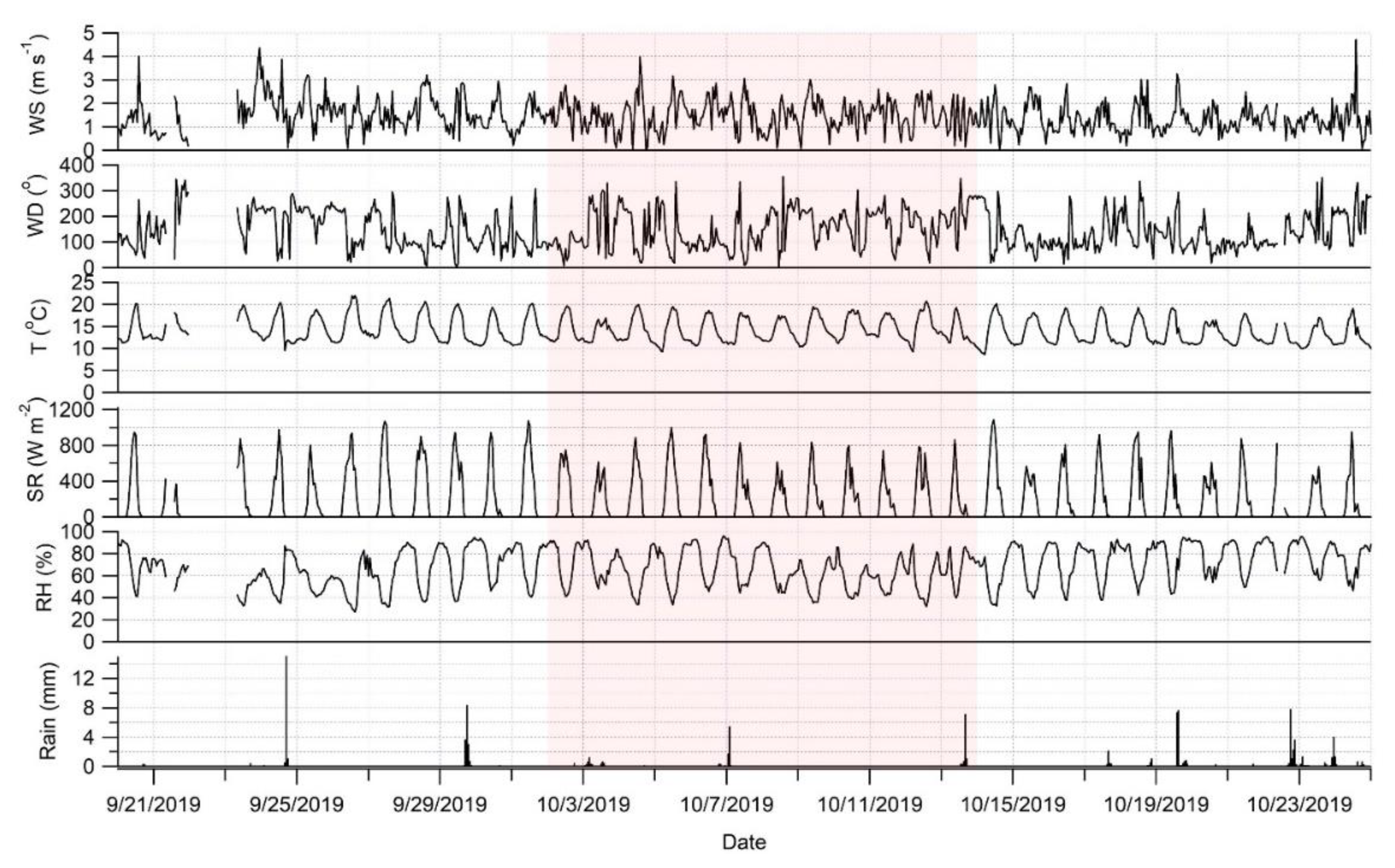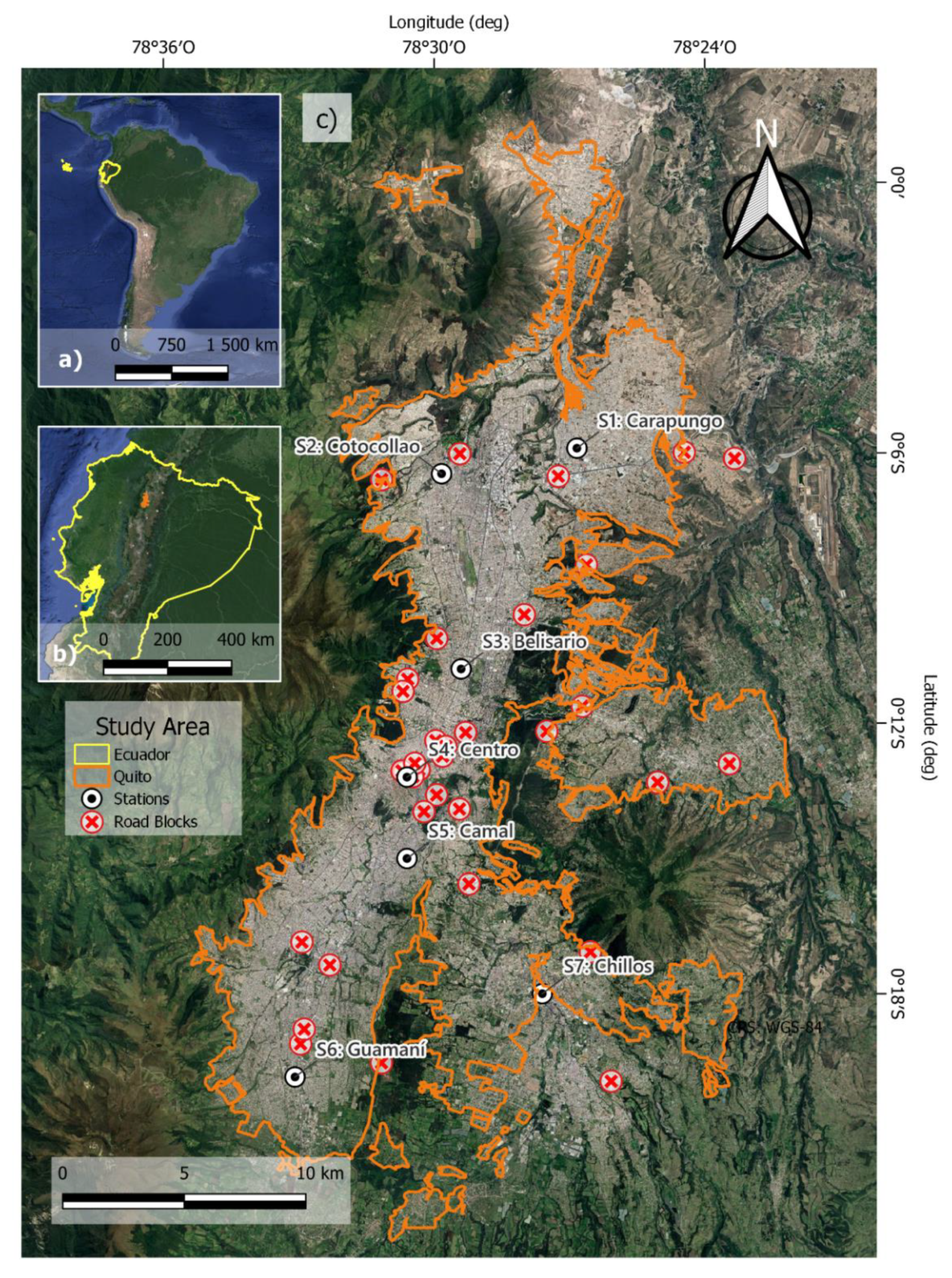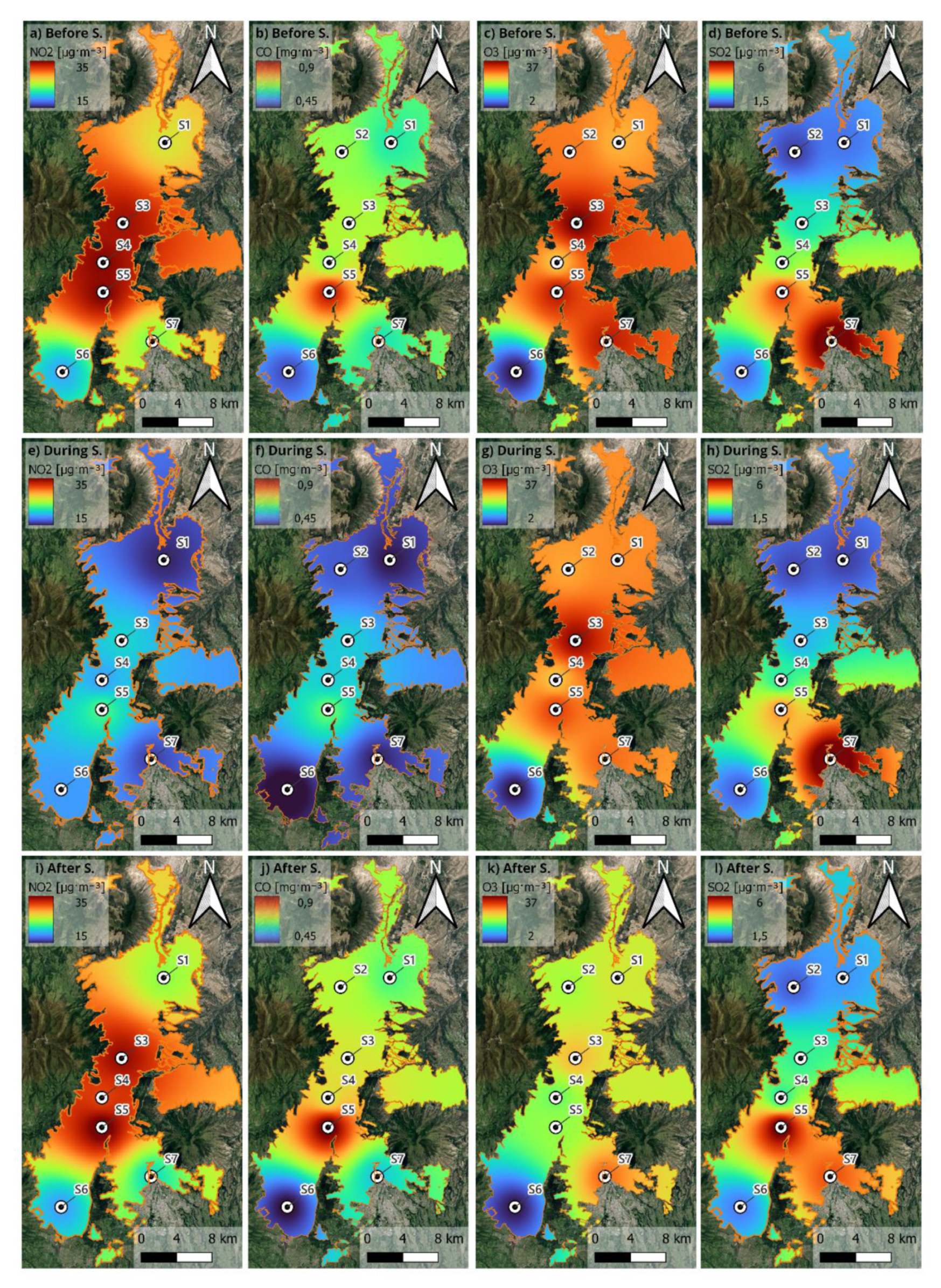Gradient Boosting Machine to Assess the Public Protest Impact on Urban Air Quality
Abstract
:1. Introduction
2. Materials and Methods
2.1. Study Sites, Data Analysis and Visualization
2.2. Machine Learning Modelling
3. Results and Discussion
3.1. Inter-Period Observational Approach
3.2. Machine Learning (ML) Approach
3.3. Assessment of the Methods
4. Conclusions
Author Contributions
Funding
Institutional Review Board Statement
Informed Consent Statement
Data Availability Statement
Acknowledgments
Conflicts of Interest
Appendix A

| Data Set | I-P | GBM |
|---|---|---|
| CO | X | X |
| NO2 | X | X |
| SO2 | X | X |
| O3 | X | X |
| Solar radiation | X | X |
| Temperature | X | X |
| Pressure | X | |
| Relative humidity | X | X |
| Precipitation | X | X |
| Wind direction | X | X |
| Wind speed | X | X |
| Hour | X | |
| Weekday | X | |
| Year day | X | |
| Date trend | X |
| NO2 | SO2 | CO | O3 | |||||
|---|---|---|---|---|---|---|---|---|
| R2 | RMSE | R2 | RMSE | R2 | RMSE | R2 | RMSE | |
| S1-Cotocollao | 0.84 | 4.10 | 0.71 | 1.25 | 0.77 | 0.17 | 0.91 | 5.39 |
| S2-Carapungo | 0.76 | 5.97 | 0.58 | 2.11 | 0.71 | 0.19 | 0.90 | 5.71 |
| S3-Belisario | 0.74 | 6.21 | 0.48 | 2.27 | 0.78 | 0.18 | 0.89 | 6.64 |
| S4-Centro | 0.74 | 6.50 | 0.57 | 2.43 | 0.74 | 0.22 | 0.90 | 5.55 |
| S5-Camal | 0.72 | 7.02 | 0.64 | 4.38 | 0.74 | 0.25 | 0.89 | 6.82 |
| S6-Guamani | 0.77 | 5.93 | 0.34 | 1.77 | 0.70 | 0.20 | 0.88 | 6.89 |
| S7-Chillos | 0.68 | 6.00 | 0.43 | 6.83 | 0.77 | 0.13 | 0.88 | 7.77 |
| Overall Mean | 0.75 | 5.96 | 0.53 | 3.01 | 0.74 | 0.19 | 0.89 | 6.40 |
References
- United States Environmental Protection Agency. Criteria Air Pollutants. 2021. Available online: https://www.epa.gov/criteria-air-pollutants (accessed on 3 April 2021).
- United Nation. UNDESA World Social Report 2020. Department of Economic and Social Affairs Social Inclusion, 2021. Available online: https://www.un.org/development/desa/dspd/world-social-report/2020-2.html (accessed on 3 April 2021).
- Shek, D.T.L. Protests in Hong Kong (2019–2020): A perspective based on quality of life and well-being. Appl. Res. Qual. Life 2020, 15, 619–635. [Google Scholar] [CrossRef] [Green Version]
- Ting, T. From ‘be water’ to ‘be fire’: Nascent smart mob and networked protests in Hong Kong. Soc. Mov. Stud. 2020, 19, 362–368. [Google Scholar] [CrossRef]
- Brimblecombe, P. Street protests and air pollution in Hong Kong. Environ. Monit. Assess. 2020, 192, 295. [Google Scholar] [CrossRef]
- Dettmer, J. 2019—A Year of Protest; Voice of America. 2019. Available online: https://www.voanews.com/europe/2019-year-protest (accessed on 20 September 2021).
- Cerna, D.C. La protesta feminista en México: La misoginia en el discurso institucional y en las redes sociodigitales. Rev. Mex. Cienc. Polit. Soc. 2020, 65, 177–205. [Google Scholar] [CrossRef]
- Rebón, J.; Encina, C.R. Revueltas en y contra el neoliberalismo. Argentina, 2001 y Chile, 2019. Sociedad 2020, 40, 157–173. [Google Scholar]
- Stefanoni, P. Qué pasa en Bolivia? Nueva Sociedad. 2019. Available online: https://nuso.org/articulo/Bolivia-Evo-Morales-Carlos-Mesa-elecciones/ (accessed on 23 February 2021).
- Chapula, A.E. Reelección Presidencial en Bolivia, 2005–2019; Universidad Autónoma de Guerrero: Chilpancingo de los Bravo, Mexico, 2020. [Google Scholar]
- Pinzón, É.R. Colombia 2020: La Movilización Social Como Oportunidad y Reflejo del Cambio; Analisis Fundacion Carolina, 2020; Available online: https://www.fundacioncarolina.es/wp-content/uploads/2020/01/AC-1.20.pdf (accessed on 16 December 2021).
- Bastos, S.; Andrade, S. Ecuador, octubre de 2019: Fue un movimiento de jóvenes, jóvenes indígenas y más. Encartes 2020, 3, 235–237. [Google Scholar] [CrossRef]
- Buben, J.; Radek, A.; Kouba, K. Nicaragua in 2019: The surprising resilience of authoritarianism in the aftermath of regime crisis. Rev. Cienc. Polít. 2020, 40, 431–455. [Google Scholar] [CrossRef]
- BBC News. Renuncia Manuel Merino: La Ola de Protestas en Perú que Dejó Dos Muertos y 100 Heridos y Culminó con la Dimisión del Presidente. Mundo, 2020. Available online: https://www.bbc.com/mundo/noticias-america-latina-54948270 (accessed on 20 September 2021).
- Zalakeviciute, R.; Alexandrino, K.; Mejia, D.; Bastidas, M.G.; Oleas, N.H.; Gabela, D.; Chau, P.N.; Bonilla-Bedoya, S.; Diaz, V.; Rybarczyk, Y. The effect of national protest in Ecuador on PM pollution. Sci. Rep. 2021, 11, 17591. [Google Scholar] [CrossRef] [PubMed]
- Franzosi, R. One hundred years of strike statistics: Methodological and theoretical issues in quantitative strike research. ILR Rev. 1989, 42, 348–362. [Google Scholar] [CrossRef]
- Ortiz, I.; Burke, S.; Berrada, M.; Cortes, H. World protests 2006–2013. In SSRN: Initiative for Policy Dialogue and Friedrich-Ebert-Stiftung New York Working Paper No. 2013; 2014; Available online: https://papers.ssrn.com/sol3/papers.cfm?abstract_id=2374098 (accessed on 20 September 2021).
- Chiquetto, J.B.; Alvim, D.S.; Rozante, J.R.; Faria, M.; Rozante, V.; Gobo, J.P.A. Impact of a truck Driver’s strike on air pollution levels in São Paulo. Atmos. Environ. 2021, 246, 118072. [Google Scholar] [CrossRef]
- Meinardi, S.; Nissenson, P.; Barletta, B.; Dabdub, D.; Rowland, F.S.; Blake, D.R. Influence of the public transportation system on the air quality of a major urban center. A case study: Milan, Italy. Atmos. Environ. 2008, 42, 7915–7923. [Google Scholar] [CrossRef] [Green Version]
- Basagaña, X.; Triguero-Mas, M.; Agis, D.; Perez, N.; Reche, C.; Alastuey, A.; Querol, X. Science of the total environment effect of public transport strikes on air pollution levels in Barcelona (Spain). Sci. Total Environ. 2018, 610–611, 1076–1082. [Google Scholar] [CrossRef]
- Mahalakshmi, D.V.; Sujatha, P.; Naidu, C.V.; Chowdary, V.M. Contribution of vehicular emission on urban air quality: Results from public strike in Hyderabad. Indian J. Radio Space Phys. 2014, 43, 340–348. [Google Scholar]
- Xiang, J.; Austin, E.; Gould, T.; Larson, T.; Shirai, J.; Liu, Y.; Marshall, J.; Seto, E. Impacts of the COVID-19 responses on traffic-related air pollution in a Northwestern US city. Sci. Total Environ. 2020, 747, 141325. [Google Scholar] [CrossRef]
- Giani, P.; Castruccio, S.; Anav, A.; Howard, D.; Hu, W.; Crippa, P. Short-term and long-term health impacts of air pollution reductions from COVID-19 lockdowns in China and Europe: A modelling study. Lancet Planet. Health 2020, 4, e474–e482. [Google Scholar] [CrossRef]
- Huang, L.; Liu, Z.; Li, H.; Wang, Y.; Li, Y.; Zhu, Y.; Gee Ooi, M.C.; An, J.; Shang, Y.; Zhang, D.; et al. The silver lining of COVID-19: Estimation of short-term health impacts due to lockdown in the Yangtze River Delta Region, China. GeoHealth 2020, 4, e2020GH000272. [Google Scholar] [CrossRef]
- Rybarczyk, Y.; Zalakeviciute, R. Assessing the COVID-19 impact on air quality: A machine learning approach, Geophys. Res. Lett. 2021, 48, e2020GL091202. [Google Scholar] [CrossRef]
- Instituto Nacional de Estadistica y Cencos. Datosmacro.com. Ecuador-Población; Expansion, 2019. Available online: https://datosmacro.expansion.com/demografia/poblacion/ecuador (accessed on 6 July 2021).
- Worldometer. Countries in South America by Population. 2021. Available online: https://www.worldometers.info/population/countries-in-south-america-by-population/ (accessed on 6 July 2021).
- Zalakeviciute, R.; López-Villada, J.; Rybarczyk, Y. Contrasted effects of relative humidity and precipitation on urban PM2.5 pollution in high elevation urban areas. Sustainability 2018, 10, 2064. [Google Scholar] [CrossRef] [Green Version]
- Instituto Nacional de Estadísticas y Censos (INEC). Proyecciones Poblacionales. Poblacion, 2013. Available online: https://web.archive.org/web/20131018060046/https://www.ecuadorencifras.gob.ec/proyecciones-poblacionales/ (accessed on 6 October 2021).
- Zalakeviciute, R.; Rybarczyk, Y.; Villada, J.L.; Suarez, M.V.D. Quantifying decade-long effects of fuel and traffic regulations on urban ambient PM2.5 pollution in a mid-size South American city. Nat. Sci. Rep. 2018, 9, 66–75. [Google Scholar]
- Zalakeviciute, R.; Bastidas, M.; Buenaño, A.; Rybarczyk, Y. A traffic-based method to predict and map urban air quality. Appl. Sci. 2020, 10, 2035. [Google Scholar] [CrossRef] [Green Version]
- Secretaría de Ambiente. Secretaria de Ambiente: Informe Final Inventario de Emisiones de Contaminantes Criterio; DMQ: Distrito Metropolitano de Quito, Ecuador, 2011; p. 53. [Google Scholar]
- Grange, S.K.; Carslaw, D.C.; Lewis, A.C.; Boleti, E.; Hueglin, C. Random forest meteorological normalisation models for Swiss PM10 trend analysis. Atmos. Chem. Phys. 2018, 18, 6223–6239. [Google Scholar] [CrossRef] [Green Version]
- Sharma, A.R.; Kharol, S.K.; Badarinath, K.V.S. Influence of vehicular traffic on urban air quality—A case study of Hyderabad, India. Transp. Res. Part. D 2010, 15, 154–159. [Google Scholar] [CrossRef]
- Debone, D.; Leirião, L.F.L.; Miraglia, S.G.E.K. Air quality and health impact assessment of a truckers’ strike in Sao Paulo state, Brazil: A case study. Urban. Clim. 2020, 34, 100687. [Google Scholar] [CrossRef]
- De Silva, D.C.E.; Marcusso, R.M.N.; Barbosa, C.G.G.; Gonçalves, F.L.T.; Cardoso, M.R.A. Air pollution and its impact on the concentration of airborne fungi in the megacity of São Paulo, Brazil. Heliyon 2020, 6, e05065. [Google Scholar] [CrossRef]
- European Commission. Air quality: Traffic Measures Could Effectively Reduce NO2 Concentrations by 40% in Europe’s Cities; The European Commission’s Science and Knowledge Service. 2019. Available online: https://ec.europa.eu/jrc/en/news/air-quality-traffic-measures-could-effectively-reduce-no2-concentrations-40-europe-s-cities (accessed on 7 February 2021).
- Pilecka, J.; Grinfelde, I.; Purmalis, O.; Burlakovs, J. Car transport intensity impact on heavy metal distribution in urban environment. IOP Conf. Ser. Earth Environ. Sci. 2020, 578, 12032. [Google Scholar] [CrossRef]
- Cazorla, M.; Herrera, E.; Palomeque, E.; Saud, N. What the COVID-19 lockdown revealed about photochemistry and ozone production in Quito, Ecuador. Atmos. Pollut. Res. 2021, 12, 124–133. [Google Scholar] [CrossRef]
- Wang, Y.; Yuan, Y.; Wang, Q.; Liu, C.; Zhi, Q.; Cao, J. Changes in air quality related to the control of coronavirus in China: Implications for traffic and industrial emissions. Sci. Total Environ. 2020, 731, 139133. [Google Scholar] [CrossRef]
- Bauwens, M.; Compernolle, S.; Stavrakou, T.; Muller, J.-F.; van Gent, J.; Eskes, H.; Levelt, P.F.; van der Veefkind, A.J.P.; Vlietinck, J.; Uy, H.; et al. Impact of coronavirus outbreak on NO2 pollution assessed using TROPOMI and OMI observations. Geophys. Res. Lett. 2020, 47, e2020GL087978. [Google Scholar] [CrossRef]
- Ding, J.; van der Veefkind, A.J.P.; Eskes, B.; Mijling, B.; Stavrakou, T.; van Geffen, J.H.M. NOx emissions reduction and rebound in China due to the COVID-19 crisis. Geophys. Res. Lett. 2020, 47, e2020GL089912. [Google Scholar] [CrossRef]
- Petetin, H.; Bowaldo, D.; Soret, A.; Guevara, M.; Jorba, O.; Serradell, K.; Garcia-Pando Perez, C. Meteorology-normalized impact of the COVID-19 lockdown upon NO2 pollution in Spain. Atmos. Chem. Phys. 2020, 20, 11119–11141. [Google Scholar] [CrossRef]
- Liu, F.; Wang, M.; Zheng, M. Effects of COVID-19 lockdown on global air quality and health. Sci. Total Environ. 2021, 755, 142533. [Google Scholar] [CrossRef] [PubMed]
- Maratea, A.; Petrosino, A.; Manzo, M. Extended Graph Backbone for Motif Analysis. In Proceedings of the 18th International Conference on Computer Systems and Technologies, Ruse, Bulgaria, 23–24 June 2017; pp. 36–43. [Google Scholar]
- Abián, M.; Millera, Á.; Bilbao, R.; Alzueta, M.U. Impact of SO2 on the formation of soot from ethylene pyrolysis. Fuel 2015, 159, 550–558. [Google Scholar] [CrossRef]
- Zalakeviciute, R.; Vasquez, R.; Bayas, D.; Buenano, A.; Mejia, D.; Zegarra, R.; Diaz, V.; Lamb, B. Drastic improvements in air quality in Ecuador during the COVID-19 outbreak. Aerosol Air Qual. Res. 2020, 20, 1783–1792. [Google Scholar] [CrossRef]
- Sokhi, R.S.; Singh, V.; Querol, X.; Finardi, S.; Targino, A.C.; de Fatima Andrade, M.; Pavlovic, R.; Garland, R.M.; Massague, J.; Kong, S.; et al. A global observational analysis to understand changes in air quality during exceptionally low anthropogenic emission conditions. Environ. Int. 2021, 157, 106818. [Google Scholar] [CrossRef] [PubMed]



| Inter-Period Estimated Change | NO2 | CO | O3 | SO2 | ||||
|---|---|---|---|---|---|---|---|---|
| During | After | During | After | During | After | During | After | |
| S1-Carapungo | −41.77 | 0.94 | −25.31 | 4.2 | 7.41 | −13.82 | −16.14 | 12.57 |
| S2-Cotocollao | ND | ND | −25.58 | 3.39 | −7.55 | −31.31 | 2.64 | 9.94 |
| S3-Belisario | −38.57 | 0.94 | −15.28 | 3.72 | −2.64 | −31.98 | −13.81 | 7.42 |
| S4-Centro | −44.89 | −8.51 | −12.84 | 7.06 | 0.04 | −29.42 | −10.91 | −11.24 |
| S5-Camal | −33.92 | 2.7 | −25.84 | 6.09 | −8.32 | −45.22 | −10.02 | 18.15 |
| S6-Guamani | −2.41 | −1.3 | −10.63 | −8.33 | −11.11 | −14.07 | −4.16 | 5.68 |
| S7-Chillos | −32.63 | −11.54 | −23.47 | −4.81 | −14.07 | −14.57 | 1.99 | −19.46 |
| Overall Mean | −32.37 | −2.80 | −19.85 | 1.62 | −5.18 | −25.77 | −7.20 | 3.29 |
| ±15.39 | ±5.82 | ±6.67 | ±5.83 | ±7.32 | ±12.01 | ±7.48 | ±13.56 | |
| ML Estimated Change | NO2 | CO | O3 | SO2 | ||||
|---|---|---|---|---|---|---|---|---|
| During | After | During | After | During | After | During | After | |
| S1-Carapungo | −32.55 | −6.73 | −10.50 | 0.67 | −17.07 | −30.97 | −24.19 | 4.92 |
| S2-Cotocollao | ND | ND | −24.60 | −0.62 | −14.69 | −32.29 | 28.44 | 37.77 |
| S3-Belisario | −41.39 | −12.63 | −15.13 | −6.23 | 12.43 | −9.39 | −35.99 | −15.13 |
| S4-Centro | −39.83 | −12.08 | −15.57 | 2.96 | −1.21 | −12.19 | −33.71 | −35.28 |
| S5-Camal | −40.64 | −13.88 | −18.45 | −14.72 | 5.14 | −25.16 | −21.91 | −21.45 |
| S6-Guamani | 3.01 | −5.95 | −4.31 | −1.36 | −31.69 | −40.75 | 11.23 | 17.76 |
| S7-Chillos | −37.76 | −23.31 | −20.30 | −10.73 | −0.62 | 0.32 | −47.40 | −56.57 |
| Overall Mean | −31.53 | −12.43 | −15.55 | −4.29 | −6.82 | −21.49 | −17.65 | −9.71 |
| ±17.22 | ±6.25 | ±6.64 | ±6.50 | ±15.11 | ±14.72 | ±27.38 | ±32.25 | |
| NO2 | CO | O3 | SO2 | |||||
|---|---|---|---|---|---|---|---|---|
| GBM | I-P | GBM | I-P | GBM | I-P | GBM | I-P | |
| S1-Carapungo | 5.97 | 14.01 | 0.19 | 0.33 | 5.71 | 17.30 | 2.11 | 1.16 |
| S2-Cotocollao | ND | ND | 0.17 | 0.29 | 5.39 | 22.21 | 1.25 | 1.32 |
| S3-Belisario | 6.21 | 16.67 | 0.18 | 0.33 | 6.64 | 25.95 | 2.27 | 1.73 |
| S4-Centro | 6.50 | 16.86 | 0.22 | 0.26 | 5.55 | 17.93 | 2.43 | 2.39 |
| S5-Camal | 7.02 | 14.25 | 0.25 | 0.43 | 6.82 | 26.92 | 4.38 | 4.32 |
| S6-Guamani | 5.93 | 9.90 | 0.20 | 0.27 | 6.89 | 17.73 | 1.77 | 1.13 |
| S7-Chillos | 6.00 | 12.96 | 0.13 | 0.25 | 7.77 | 27.07 | 6.83 | 5.34 |
| Quito average | 6.27 | 14.11 | 0.20 | 0.32 | 6.17 | 21.34 | 2.37 | 2.01 |
Publisher’s Note: MDPI stays neutral with regard to jurisdictional claims in published maps and institutional affiliations. |
© 2021 by the authors. Licensee MDPI, Basel, Switzerland. This article is an open access article distributed under the terms and conditions of the Creative Commons Attribution (CC BY) license (https://creativecommons.org/licenses/by/4.0/).
Share and Cite
Zalakeviciute, R.; Rybarczyk, Y.; Alexandrino, K.; Bonilla-Bedoya, S.; Mejia, D.; Bastidas, M.; Diaz, V. Gradient Boosting Machine to Assess the Public Protest Impact on Urban Air Quality. Appl. Sci. 2021, 11, 12083. https://doi.org/10.3390/app112412083
Zalakeviciute R, Rybarczyk Y, Alexandrino K, Bonilla-Bedoya S, Mejia D, Bastidas M, Diaz V. Gradient Boosting Machine to Assess the Public Protest Impact on Urban Air Quality. Applied Sciences. 2021; 11(24):12083. https://doi.org/10.3390/app112412083
Chicago/Turabian StyleZalakeviciute, Rasa, Yves Rybarczyk, Katiuska Alexandrino, Santiago Bonilla-Bedoya, Danilo Mejia, Marco Bastidas, and Valeria Diaz. 2021. "Gradient Boosting Machine to Assess the Public Protest Impact on Urban Air Quality" Applied Sciences 11, no. 24: 12083. https://doi.org/10.3390/app112412083
APA StyleZalakeviciute, R., Rybarczyk, Y., Alexandrino, K., Bonilla-Bedoya, S., Mejia, D., Bastidas, M., & Diaz, V. (2021). Gradient Boosting Machine to Assess the Public Protest Impact on Urban Air Quality. Applied Sciences, 11(24), 12083. https://doi.org/10.3390/app112412083







